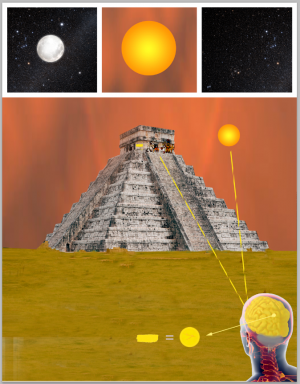Descripción
Title: Renaissance and Enlightenment
Artist: Dieter Liedtke
Innovation: Disclosure that the innovations encoded with the beginning of the Enlightenment (from the 15th century onwards) and whose creativity and innovations could no longer be interpreted by the population, through concealment and exaggeration. The state promoted separations of the majority of the population from creativity, creative power or God and the people from the Renaissance and the Enlightenment onwards. A secularisation of the Christian churches as bearers of religion, but also as guarantors of the (God-ordained) state constitutions, led to a reduction of the understanding of creativity as a power factor, which also affected the relationship to art. The ability to create and to gain knowledge was regulated as an essential means of shaping the present and the future. Where they were permitted or revealed without the permission of spiritual and secular rulers, they were subject to their censorship. Art was deliberately misdefined by the new priests of secular power, the art owners, as incomprehensible genius and divine power, and the transmission of creative power to man as innovative power was kept secret from the people, since art was increasingly becoming a commodity whose rarity (and thus its value) had to be guaranteed. The art formula that everyone understands is defamed as absurd, so that no creativity from works of art can be taken over by the people and the people do not lose their fears and disorientation through creativity. In information rituals, the goals of the leaders as well as the cohesion of communities are organised in individual or community rituals and presented as the unquestionable but binding will of God. Artistic creation is reduced to ‘genius art’, whereby the cult of genius is transferred from the art owners and exhibitors (the state) to the people. This negates any claim to creativity on the part of all individuals.
Innovation: The art formula to be understood by everyone
Innovation: The scientific art formula: i = E = MC2
Innovation: The art exhibition of the Second Renaissance: i = E = MC2
Innovation Technique: Digital print as a unique size/original work of art with Dieter Liedtke’s DNA in the red colour.
Innovation of the series: Disclosure of health, motivational and group or political social rituals. The effect of the recovery rituals can be optimised optimally through first experiences with creativity and affection previously unknown to the sick person (see research results on neurobiology, epigenetics, mirror neurons, nocebo and placebo and the ancient rituals up to the emergence of religions and today’s voodoo) or for group guidance through numerous repetitions by information mediators (see religions and media).
Series name: Art and Healing II
Years working on the series from: 1963
Year of work: 2015
Signature: Liedtke
Material: Ink, canvas on stretcher frame
Dimensions: 140 cm x 180 cm
Original-Work N°: 10/8
Art historical value expertise: Artinvest
Blockchain secured work certificate
From Wikipedia:
In democratic countries, the right to artistic freedom is either enshrined in the constitution or guaranteed within the framework of freedom of expression. In states with a different political organisation, the practice of art is often regulated and/or instrumentalised for propaganda purposes. Dictatorships often use art specifically to stabilise the respective regime. Free artistic expression is subjected to censorship and threatened with repression, or actually exposed to it. Because of such repression, artists then do not produce critical works (scissors in the head), do not publish them, or go into internal emigration. Some artists internalise the state, social and/or religious requirements and produce – out of conviction or economic constraints – affirmative works.
From Wikipedia
Plagiarism, imitation and works strongly influenced by other artists have existed and continue to exist in every phase of art history. If the producer conceals his originals, this is just as punishable as an art forgery as an infringement of copyright. In order to make such an infringement legally tangible, the legislator introduces criteria that play no role in the art business itself. For example, from the perspective of copyright law, an artist can only call a work his or her own when it has reached a sufficient level of creation. This presupposes a personal, individual and intellectual (human) creation that has a form perceptible through the human senses (see the concept of work in copyright law with regard to the level of creation). Several explanations can be offered for the biological anchoring of the need for art. The most likely is art as a selection criterion for mate choice. Human evolution is characterised by an increase in brain volume and thus in cognitive abilities. The ability to produce art is an externally recognisable indication of creativity, which can also lead to creative solutions in other problem areas. People who had time for art had no problems satisfying their daily needs for food and security, because those who had reserves for primarily meaningless activities such as art in addition to everyday life, thus represented their ability to survive. Humans as social beings have developed many mechanisms to strengthen their social communities.





Valoraciones
No hay valoraciones aún.